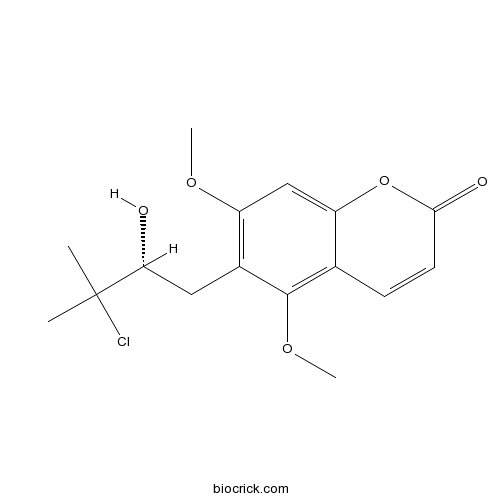6-(3-Chloro-2-hydroxy-3-methylbutyl)-5,7-dimethoxycoumarinCAS# 15575-50-5 |

Quality Control & MSDS
3D structure
Package In Stock
Number of papers citing our products

| Cas No. | 15575-50-5 | SDF | Download SDF |
| PubChem ID | 101628132 | Appearance | Powder |
| Formula | C16H19ClO5 | M.Wt | 326.77 |
| Type of Compound | Coumarins | Storage | Desiccate at -20°C |
| Solubility | Soluble in Chloroform,Dichloromethane,Ethyl Acetate,DMSO,Acetone,etc. | ||
| Chemical Name | 6-[(2R)-3-chloro-2-hydroxy-3-methylbutyl]-5,7-dimethoxychromen-2-one | ||
| SMILES | CC(C)(C(CC1=C(C=C2C(=C1OC)C=CC(=O)O2)OC)O)Cl | ||
| Standard InChIKey | JDYJPQNEOXWJQN-CYBMUJFWSA-N | ||
| Standard InChI | InChI=1S/C16H19ClO5/c1-16(2,17)13(18)7-10-11(20-3)8-12-9(15(10)21-4)5-6-14(19)22-12/h5-6,8,13,18H,7H2,1-4H3/t13-/m1/s1 | ||
| General tips | For obtaining a higher solubility , please warm the tube at 37 ℃ and shake it in the ultrasonic bath for a while.Stock solution can be stored below -20℃ for several months. We recommend that you prepare and use the solution on the same day. However, if the test schedule requires, the stock solutions can be prepared in advance, and the stock solution must be sealed and stored below -20℃. In general, the stock solution can be kept for several months. Before use, we recommend that you leave the vial at room temperature for at least an hour before opening it. |
||
| About Packaging | 1. The packaging of the product may be reversed during transportation, cause the high purity compounds to adhere to the neck or cap of the vial.Take the vail out of its packaging and shake gently until the compounds fall to the bottom of the vial. 2. For liquid products, please centrifuge at 500xg to gather the liquid to the bottom of the vial. 3. Try to avoid loss or contamination during the experiment. |
||
| Shipping Condition | Packaging according to customer requirements(5mg, 10mg, 20mg and more). Ship via FedEx, DHL, UPS, EMS or other couriers with RT, or blue ice upon request. | ||

6-(3-Chloro-2-hydroxy-3-methylbutyl)-5,7-dimethoxycoumarin Dilution Calculator

6-(3-Chloro-2-hydroxy-3-methylbutyl)-5,7-dimethoxycoumarin Molarity Calculator
| 1 mg | 5 mg | 10 mg | 20 mg | 25 mg | |
| 1 mM | 3.0603 mL | 15.3013 mL | 30.6026 mL | 61.2051 mL | 76.5064 mL |
| 5 mM | 0.6121 mL | 3.0603 mL | 6.1205 mL | 12.241 mL | 15.3013 mL |
| 10 mM | 0.306 mL | 1.5301 mL | 3.0603 mL | 6.1205 mL | 7.6506 mL |
| 50 mM | 0.0612 mL | 0.306 mL | 0.6121 mL | 1.2241 mL | 1.5301 mL |
| 100 mM | 0.0306 mL | 0.153 mL | 0.306 mL | 0.6121 mL | 0.7651 mL |
| * Note: If you are in the process of experiment, it's necessary to make the dilution ratios of the samples. The dilution data above is only for reference. Normally, it's can get a better solubility within lower of Concentrations. | |||||

Calcutta University

University of Minnesota

University of Maryland School of Medicine

University of Illinois at Chicago

The Ohio State University

University of Zurich

Harvard University

Colorado State University

Auburn University

Yale University

Worcester Polytechnic Institute

Washington State University

Stanford University

University of Leipzig

Universidade da Beira Interior

The Institute of Cancer Research

Heidelberg University

University of Amsterdam

University of Auckland

TsingHua University

The University of Michigan

Miami University

DRURY University

Jilin University

Fudan University

Wuhan University

Sun Yat-sen University

Universite de Paris

Deemed University

Auckland University

The University of Tokyo

Korea University
- 2-Hydroxy-1,8-dimethoxyxanthone
Catalog No.:BCN9481
CAS No.:38974-76-4
- Jacareubin
Catalog No.:BCN9480
CAS No.:3811-29-8
- Eudesma-4(15),7(11)-dien-8-one
Catalog No.:BCN9479
CAS No.:54707-47-0
- Pipoxide chlorohydrin
Catalog No.:BCN9478
CAS No.:29228-15-7
- Helichrysoside
Catalog No.:BCN9477
CAS No.:56343-26-1
- Kaempferol 3-O-(4''-O-trans-p-coumaroyl)rhamnopyranoside
Catalog No.:BCN9476
CAS No.:623927-14-0
- Imbricatin
Catalog No.:BCN9475
CAS No.:84504-71-2
- Trigochinin B
Catalog No.:BCN9474
CAS No.:1210299-32-3
- Nauclefine
Catalog No.:BCN9473
CAS No.:57103-51-2
- (6E,12E)-Tetradeca-6,12-diene-8,10-diyne-1,3-diol diacetate
Catalog No.:BCN9472
CAS No.:89913-46-2
- (-)-Cedrusin
Catalog No.:BCN9471
CAS No.:404335-99-5
- Trigonothyrin D
Catalog No.:BCN9470
CAS No.:1254956-09-6
- Leptostachyol acetate
Catalog No.:BCN9483
CAS No.:35770-58-2
- Rhodomyrtone
Catalog No.:BCN9484
CAS No.:468757-69-9
- Flaccidin
Catalog No.:BCN9485
CAS No.:115531-76-5
- Methoxyimbricatin
Catalog No.:BCN9486
CAS No.:233759-30-3
- 3-O-Debenzoylzeylenone
Catalog No.:BCN9487
CAS No.:1800008-77-8
- 24,24-Dimethyl-5α-lanosta-9(11),25-dien-3β-ol
Catalog No.:BCN9488
CAS No.:33762-29-7
- Vesticarpan
Catalog No.:BCN9489
CAS No.:69853-46-9
- (-)-Sesamin 2,2'-diol
Catalog No.:BCN9490
CAS No.:1152441-87-6
- 2,4,3',4',6'-Penta-O-(3-methylbutanoyl)sucrose
Catalog No.:BCN9491
CAS No.:150302-84-4
- Chrysosplenol C
Catalog No.:BCN9492
CAS No.:23370-16-3
- 5-Hydroxy-3,6,7,4'-tetramethoxyflavone
Catalog No.:BCN9493
CAS No.:14787-34-9
- Phrymarolin V
Catalog No.:BCN9494
CAS No.:1449376-84-4
[Studies on the chemical constituents of Rutaceae++ plants. LXVI. The chemical constituents of Toddalia asiatica (L.) Lam. (T. aculeata Pers.). (1). Chemical constituents of the root bark].[Pubmed:1783985]
Yakugaku Zasshi. 1991 Jul;111(7):365-75.
Chemical constituents of the root bark of Toddalia asiatica (L.) Lam. (T. aculeata Pers.), Rutaceae, were examined. In addition to twelve known coumarins [toddaculin (2), coumurrayin (5), toddanone (6), 8-(3,3-dimethylallyl)-6,7-dimethoxycoumarin (7), isopimpinellin (8), 6-(3-Chloro-2-hydroxy-3-methylbutyl)-5,7-dimethoxycoumarin (9), 6-formyllimettin (10), 5,7,8-trimethoxycoumarin (12), toddasin (13), (+)-toddanol (14), 6-(2-hydroxy-3-methoxy-3-methylbutyl)-5,7-dimethoxycoumarin (18), and toddalolactone (21)] five new coumarins [toddalenol (17), toddalosin (19), 5-methoxysuberenon (23), toddalenone (24), and 8-formyllimettin (25)] were isolated. Furthermore seven known benzo[c]phenanthridine alkaloids [des-N-methylchelerythrine (4), oxychelerythrine (15), arnottianamide (16), oxyavicine (22), avicine (30), chelerythrine (31), and chelerythrine-psi-cyanide (34)] and four known quinoline alkaloids [N-methylflindersine (11), 4-methoxy-1-methyl-2-quinolone (20), skimmianine (35), integriquinolone (36)], one known triterpenoid [beta-amyrin (3)], and four unknown components [unknown I-IV (26)-(29)] were isolated.


